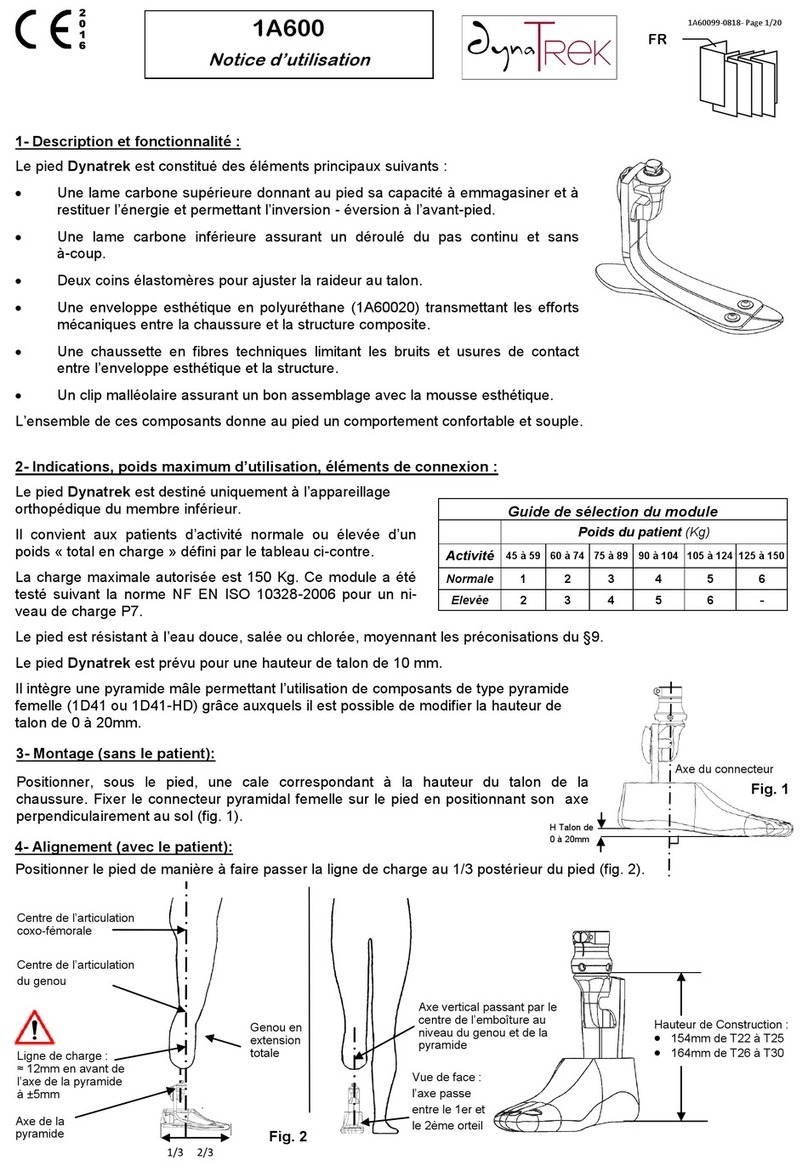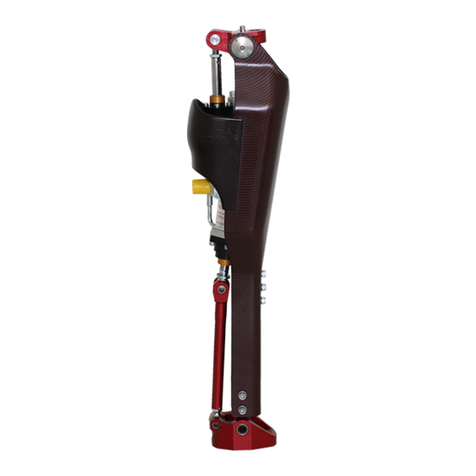
NOTICE D’UTILISATION Page 4 sur 7
OPEN uniquement, contient 3 positions : 1, 2 et 3 de souple à ferme.
•Commande ROUGE (REBOUND) correspondant à la vitesse du retour en extension.
D. Ré la e de la pression de l’amortisseur
A l’aide de la pompe fournie, mettre l’amortisseur à la pression désirée.
En cas d’excès de pression, faire baisser celle-ci à l’aide du bouton de purge situé sur la pompe.
Utiliser uniquement la pompe fournie ou une pompe munie d’un manomètre 20 bars et adaptée aux amortisseurs FOX.
Les combinaisons de positions ainsi que les réglages indiqués ci-dessous sont donnés à titre indicatif et sont susceptibles de varier en
fonction des activités et du poids du patient :
Activités sportives :
1. Position axe :
•VELO : vélo de route, VTT rando, VTT descente et motocross
•GLISSE : toutes autres activités
2. Ré la e de la flexion :
•OPEN (commande bleue)
3. Ré la e de l’extension :
•REBOUND au maximum en général et à adapter en fonction du besoin (commande rouge)
4. Pression :
•0 bar : Vélo de route, VTT de rando
•1 à 3 bars : Surf, paddle, ski nautique, wakeboard
•4 à 6 bars : VTT descente, snowboard, ski de piste
•5 à 10 bars : Fitness, sport de raquettes, sports de combat, moto-cross
La pression d’air de l’amortisseur ne doit jamais dépasser 20,6 bars.
Il est impératif de vider l’air de l’amortisseur lors d’un passage en haute altitude (voyage en avion…).
Remettre le capuchon sur la valve après un réglage de la pression d’air.
Déplacements entre activités / franchissement d’obstacles / besoin de sécurité :
1. Réglage de la flexion :
•FIRM (commande bleue)
7. DETECTION DES DYSFONCTIONNEMENTS
Si vous constatez un comportement anormal ou que vous sentez des modifications des caractéristiques du dispositif, ou si celui-ci a reçu
un choc important, consultez votre orthoprothésiste.
8. MISES EN GARDE, CONTRE-INDICATIONS, EFFETS SECONDAIRES
A. Mises en arde
Lors des premières utilisations du genou, il est possible que des traces d’huile apparaissent. Les essuyer à l’aide d’un chiffon
doux.
L’amortisseur, ayant subi une préparation spécifique, ne doit en aucun cas être démonté ou détourné de son utilisation.
Laisser refroidir l’amortisseur après utilisation, risque de brûlures.
En cas de changement de température important de l’amortisseur, son comportement peut varier.
L’amortisseur est livré dégonflé pour éviter tout problème lors de son transport.
Un risque de coincement de doigt ou de pincement des vêtements dans l’articulation du genou existe. Pour éviter tout risque de
blessure du fait du mouvement de l’articulation, bien veiller à ce que personne ne mette les doigts à proximité ou à l’intérieur du
mécanisme.
B. Contre-indications
Ne jamais graisser les axes du genou, cela pourrait entrainer leur détérioration rapide.
En cas de port de charge, le fonctionnement du genou peut être perturbé.
La garantie ne couvre pas les détériorations consécutives à un mauvais usage, à un alignement inadapté, à une utilisation dans un
environnement non adapté, ou toute utilisation inappropriée.
En cas de dysfonctionnement, d’usure prématurée ou de traces de rouille, consulter au plus vite votre orthoprothésiste
Ne jamais laisser ce dispositif près d’une source de chaleur : risque de brûlure et de dégagement toxique.






























